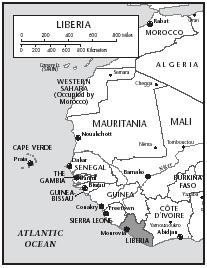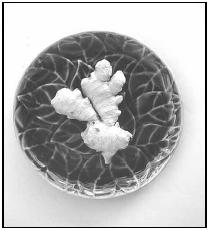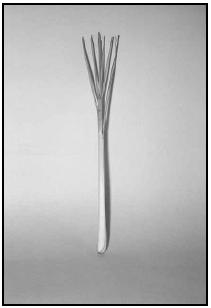Liberia
Recipes

1 GEOGRAPHIC SETTING AND ENVIRONMENT
Located on the west coast of Africa, Liberia has an area of about 43,000 square miles (111,370 square kilometers), slightly larger than the state of Tennessee. The Nimba Mountains, near the Guinea border, rise to 4,528 feet (1,380 meters), and the Wologizi Mountains reach a maximum of about 4,450 feet (1,356 meters). There are six principal rivers, all of which flow into the Atlantic Ocean. Liberia includes some of Africa's most impressive evergreen forests. Fruit trees include citrus varieties, the alligator apple, papaya, mango, and avocado. Pineapples grow wild. Agricultural crops include cassava, rice, sugarcane, plantains, and bananas.
2 HISTORY AND FOOD
Liberia was founded in 1822 for the resettlement of freed American slaves. Its name comes from the Latin word that means "free." The capital city of Monrovia is named after the U.S. president James Monroe, who established the Republic of Liberia. Much of the culture and foods from Liberia are adapted from African American culture. This can be seen in the American currency that is often used to purchase groceries and in the American English language that is spoken on the streets of Monrovia. Rioting Liberians calling for cheaper rice in 1980 supported a failed coup against the American-Liberian government. There are thirty native Liberians for every one American Liberian, but American Liberians have control over the official government. Native Liberians fought a civil war against American Liberians from 1988–1995. Since then, the country has struggled to recover and make enough food for its people.
3 FOODS OF THE LIBERIANS
Many Liberians grow their own rice, sugar cane, and cassava (a starchy root). Rice is eaten at least twice a day (much more than any other starch). Foreign rice, or pasava , is considered much better than locally grown

Fufu (a doughy food that accompanies most meals) can be made from rice, plantain, cassava, corn, or yam. The starchy food is dried, pounded until ground, boiled, and rolled into two-inch ovals. Most Liberians use cassava to make fufu; a variation, called dumboy, is boiled before mashing. Fufu is swallowed instead of chewed. It is popularly eaten with a spicy soup. Beef internal soup is made with beef, dried codfish, tripe, and other smoked fish caught from the nearby ocean. Hot peppers are added to many foods for an extra kick, and ground cayenne peppers are used as flavorings and preservatives. Favorite dishes include palava sauce, made traditionally with plato (okra) leaves, dried fish or meat, and palm oil; and jollof rice, a chicken, beef, and bacon dish with vegetables and rice. Palava sauce comes primarily from the counties of Maryland and Grand Kru.
Palava
Ingredients
- 1½ pounds cubed beef
- 1 onion, sliced
- 2 tomatoes, peeled and sliced
- Ginger, to taste
- Red pepper, to taste
- ¼–½ cup peanut oil
- 2 10-ounce packages of frozen, chopped spinach
Procedure
- Boil meat in a little water until tender, about 45 minutes.
- Fry onion, tomatoes, and spices in oil.
- Add spinach and meat to the onions and tomatoes, and simmer 10–15 minutes.
Serves 6.
Jollof Rice
Ingredients
- 1 pound boneless chicken
- ½ pound beef cubes
- ½ pound bacon
- ½ cup oil or shortening
- 2 onions, sliced
- 1 pepper, sliced
- 3 ounces tomato paste
- 1½ pounds cabbage, cut into chunks
- 1½ cups rice
- 6 cups water
Procedure
- Cut chicken, beef, and bacon into ½-inch chunks. Sprinkle with salt and pepper to taste, and coat with flour.
- Heat oil in a frying pan, add the meat in small batches, and brown the meat. Remove the meat, setting it aside in a bowl.
- Sauté the onions and pepper in the oil in pot until soft, about 5 minutes.
- Return the meat to the pot and add the tomato paste.
- Add water, cover, and heat to boiling. Lower heat and simmer for 10 minutes.
- Add rice, bring to a boil. Reduce heat.
- Add cabbage, and simmer, stirring often, for 20 minutes.
- Serve while hot.
Serves 12 or more.
Sweet Potato Pone
Ingredients
- 1 to 2 cups flour
- 1½ teaspoons baking powder
- ½ teaspoon salt
- ¼ teaspoon ground cloves
- ¼ teaspoon cinnamon
- ¼ teaspoon nutmeg
- 2 eggs slightly beaten
- 2 cups sweet potatoes, mashed and chilled
- Oil for deep-frying
Procedure
- Combine flour, baking powder, salt, cloves, cinnamon, and nutmeg in a bowl and stir well to combine.
- In another large mixing bowl, beat the eggs and sweet potatoes together.
- Add the dry mixture to the wet mixture until a stiff dough is formed.
- Roll out dough on a lightly floured surface to ½-inch thickness and cut into shapes.
- Heat about 1 inch of oil in a deep saucepan. Fry dough in batches for about 4 minutes.
- Drain, cool, dust with powdered sugar (optional), and serve.
Rice Bread
Ingredients
- 2 cups rice, cooked and mashed
- 3 Tablespoons sugar
- 4 teaspoons baking powder
- ½ teaspoon salt
- 1½ bananas, mashed
- 2 eggs
- 1½ cups milk
- 1 cup oil

Procedure
- Mix together rice, sugar, baking powder, and salt.
- Add bananas, eggs, milk, and oil.
- Bake in a greased 9- by 12-inch pan at 375°F for 45 minutes.
Ginger Beer
Ingredients
- 25 pieces ginger
- 2 pineapples, unpeeled and cut into pieces
- 2 teaspoons yeast
- 1 gallon water
- 3½ cups molasses
Procedure
- Beat ginger pieces in a large kettle until soft.
- Add pineapple and yeast.
- Boil water and pour into ginger mixture. Let stand overnight.
- Strain, and add the molasses.
- Chill and serve.
Lemon Grass Tea
Ingredients
- 1 cup chopped lemon grass leaves (can be found at Asian or health foods stores)
- 2 cups water
- Sugar (optional)
- Milk (optional)
Procedure
- Put the lemon grass leaves in a teapot.
- Boil water and pour over leaves. Steep for five minutes.
- May serve with sugar and milk.
Serves 2.
4 FOOD FOR RELIGIOUS AND HOLIDAY CELEBRATIONS
Liberians celebrate Independence Day on July 26; it is the biggest holiday in the country. They also celebrate most American holidays like New Year's (January 1), Thanksgiving (the first Thursday in November), and Christmas (December 25). Christmas is celebrated with a large meal, without gift-giving or Christmas trees. Goat soup is the national soup, served on important occasions. Coffee is also served after special

Goat Soup
Ingredients
- 2 pounds goat meat (can substitute lamb or beef)
- Hot peppers
- 2 medium onions, sliced
- 2 quarts water
- 3 tomatoes
- 8 ounces tomato paste
- Salt, black pepper
Procedure
- Cut up the meat into 2–3 inch pieces.
- Marinate with peppers, salt, black pepper, and onion for about an hour.
- Add water and boil until meat is tender.
- Add tomatoes and paste and cook until tomatoes are soft.
5 MEALTIME CUSTOMS
In Liberia, the table is set with turned over plates and glasses with a napkin on top, so that the guest may turn over the clean dishes for use. Those at the meal greet each other by shaking hands. While shaking, they take the middle finger of the other person's right hand and snap it up and down. This tradition comes from the days of slavery, when the slave owner would break a slave's finger in order to establish ownership. The handshake (or "snapshake") celebrates Liberia's freedom from slavery.
The cook brings out all the food at once, and stays seated at the table during the entire meal. All the dishes remain on the table until the end of the meal. Most Liberians will eat with their fingers, although American customs have brought utensils to the dining rooms of many city people. A typical Liberian dinner consists of dumboy or fufu served with palm butter and palava sauce, meat stew, country chop (a mixture of meats, fish, and greens cooked in palm oil), jollof rice, and beef internal soup. Rice bread and sweet potato pone are served for dessert, and ginger beer is drunk throughout the meal. Coffee is served only on special occasions.
In the city of Monrovia, there are some modern restaurants, but in most towns there are small "cook shops" that offer stews and fufu. Most cooking is still done outside on a stone hearth.
6 POLITICS, ECONOMICS, AND NUTRITION
About 42 percent of the population of Liberia are classified as undernourished by the World Bank. This means they do not receive adequate nutrition in their diet. Of children under the age of five, over 33 percent are stunted (short for their age).
According to the Liberian government, only about 39 percent of the population have access to health care services, and there are virtually no functioning social services. The Liberian staple diet of rice or cassava is deficient in protein, and children in particular suffer from the malnutrition.
7 FURTHER STUDY
Books:
DeWitt, Dave. Flavors of Africa: Spicy African Cooking. Rocklin, CA: Prima Publishing, 1998.
Hachten, Harva. Best of Regional African Cooking. New York: Hippocrene Books, Inc., 1998.
Hultman, Tami. The Africa News Cookbook. New York: Hamilton Printing Company, 1986.
Odarty, Bill. A Safari of African Cooking . Detroit, MI: Broadside Press, 1992.
Websites:
Liberian Connection. [Online] Available http://www.liberian-connection.com (accessed February 14, 2001).
LOOOOOVE this site- its just totally awesome!!!!!!
BM, USA